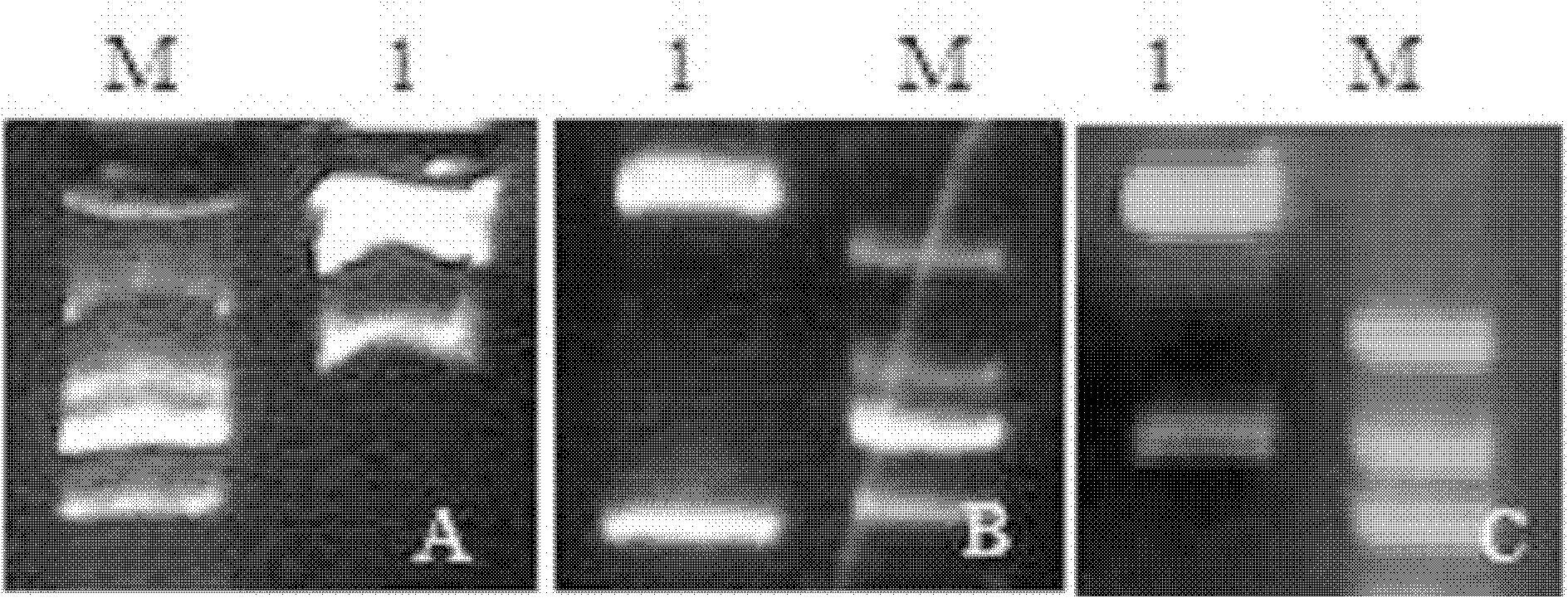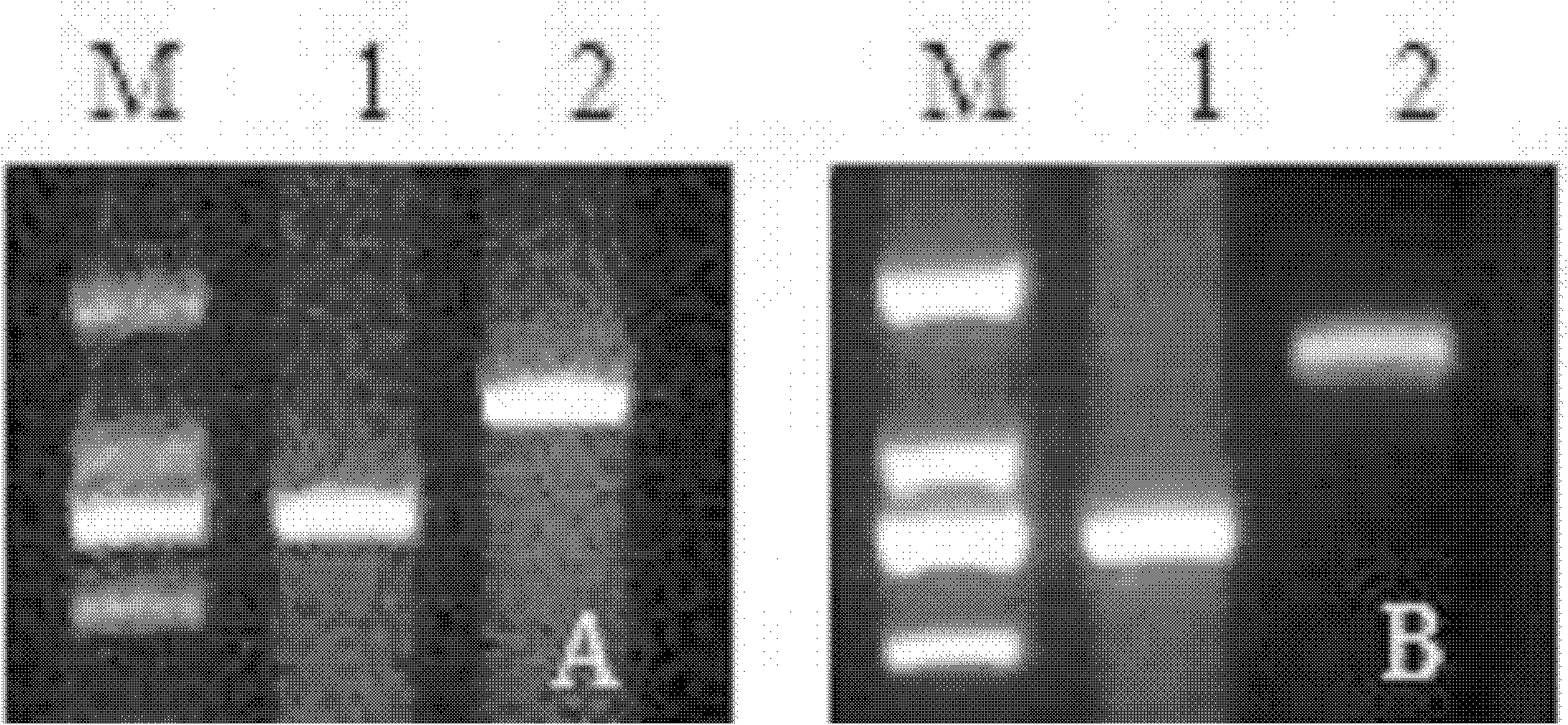Method for producing fluorescent antibacterial silks from transgenic silkworms
An antibacterial silk, transgenic technology, applied in the field of genetic engineering
- Summary
- Abstract
- Description
- Claims
- Application Information
AI Technical Summary
Problems solved by technology
Method used
Image
Examples
Embodiment 1
[0054] Example 1: A method for producing fluorescent antibacterial silk by transgenic silkworm (transgenic silkworm that expresses complete Fib-L and fuses GFP and silkworm Cecropin B)
[0055] The technical operation process is as follows:
[0056] 1. Cloning of the left arm of the gene targeting vector
[0057] The 1.2 kb left-arm primer sequence LL (SEQ ID No.1: ggt gag ctc gat caa act gca cac ggt gtg, underlined as Sac site) and LR (SEQ ID No.2: ggt tct aga gac gtg aac ctg gct ggc tg, underlined as Xba site), using the silkworm genome DNA as a template, the fragment obtained by PCR was cloned into the pMD19-T vector (for the method, refer to "Molecular Cloning", 1989, Science Press), and after sequencing verification, it was cloned into the pBluescriptⅡSK(+) vector (Stratagene company product) Sac / Xba site, and the obtained vector was named pSK-LL.
[0058] 2. Cloning of the right arm of the gene targeting vector
[0059] According to the publis...
Embodiment 2
[0078] Example 2: A method for producing fluorescent antibacterial silk by transgenic silkworm (transgenic silkworm that expresses part of the Fib-L gene and fuses GFP and silkworm Cecropin B)
[0079] The technical operation process is as follows:
[0080] 1. Cloning of the left arm of the gene targeting vector
[0081] The 1.2 kb left-arm primer sequence Fib-L-L1 (SEQ ID No.12: ttc gag ctc gtc gga cca gcc ctg ggt tg, underlined as Sac site) and Fib-L-L2 (SEQ ID No.13: ctg tct aga ttg acg atg cag tac tct tc, underlined as Xba The silkworm genomic DNA was used as a template, and the fragment obtained by PCR was cloned into the pMD19-T vector. After sequencing verification, it was cloned into the pBluescriptⅡSK(+) vector (product of Stratagene). Sac / Xba site, and the obtained vector was named pSK-FibLL.
[0082] 2. Cloning of the right arm of the gene targeting vector
[0083]The 0.5 kb right arm primer sequence Fib-L-R1 (SEQ ID No.14) of the gene ta...
Embodiment 3
[0097] Embodiment 3: A kind of transgenic silkworm that produces fluorescent antibacterial silk (expressing part of Fib-L gene, and the transgenic silkworm that fuses GFP and silkworm Cecropin B, DsRed for the negative selectable marker gene) method
[0098] The technical operation process is as follows:
[0099] 1. Cloning of the left arm of the gene targeting vector
[0100] Same as 1 in the implementation example two.
[0101] 2. Cloning of the right arm of the gene targeting vector
[0102] Same as implementation example 2 in 2.
[0103] 3. Construction of gene targeting vector
[0104] Same as 3 in the implementation example two.
[0105] 4. Construction of gene targeting vectors with negative selectable marker genes
[0106] In order to increase the frequency of gene targeting, a negative selection gene—red fluorescent reporter gene was introduced into the gene targeting vector DsRed . According to the published sequence (M76430) of GenBank, the specific pr...
PUM
 Login to View More
Login to View More Abstract
Description
Claims
Application Information
 Login to View More
Login to View More - R&D
- Intellectual Property
- Life Sciences
- Materials
- Tech Scout
- Unparalleled Data Quality
- Higher Quality Content
- 60% Fewer Hallucinations
Browse by: Latest US Patents, China's latest patents, Technical Efficacy Thesaurus, Application Domain, Technology Topic, Popular Technical Reports.
© 2025 PatSnap. All rights reserved.Legal|Privacy policy|Modern Slavery Act Transparency Statement|Sitemap|About US| Contact US: help@patsnap.com



